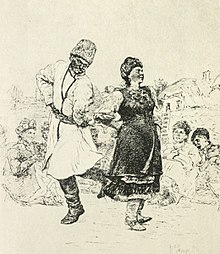Kozachok
 | |
| Native name | Козачок |
|---|---|
| Genre | Folk dance |
| Time signature | 2 4 |
Kozachok (Ukrainian: козачо́к, pronounced [ko.za.'tʃɔk]) or kazachok (Russian: казачо́к) is a traditional Ukrainian[1][2][3] quick-paced folk dance for couples originating with the Cossacks in the 16th century.[4] In the 17th and 18th centuries, it was performed throughout Ukraine, as well as at noble courts including in France, Hungary, Poland, and Russia.[4][5]
Description
Kozachok is a fast, linear, couple-dance in 2
4 time, typically in a constantly increasing tempo and of an improvisatory character. In the 17th century, kozachok became fashionable in court music in Europe.[4] It is typically in a minor key in Ukraine, and in a major key in Russia.[citation needed] The woman leads and the man follows, imitating her figures – she signals movement changes by hand clapping.[citation needed]
Traditionally it is accompanied by a pryspivka, a short, jovial, humorous song.[6]
In terms of music, Kozachok is in fact a group of "Kozachok-type dances", with numerous regional varieties, especially in Carpathians, under different names: "Kozak", "Haiduk", "Dzhuman", "Metanka", etc. At least 124 different melodies are recorded. Kozachok-type dances play the function of "dance-songs" (танець-приспівка) in most of ethnic Ukrainian lands, with the exception of "kolomyika" regions (Pokuttia, Boiko Subcarpathians, and Halychyna). [6]
In Russia there exist different versions of the kozachok dance the Kuban kazachok (Krasnodar region of southern Russia), and Terek kazachok (northern Caucasus region).[citation needed] Historically these regions had an important Ukrainian population which was significantly reduced in the Soviet era.[7]
The first known musical arrangement of the kоzachok for lute is attributed to the Polish nobleman and composer Kazimierz Stanisław Rudomina-Dusiacki in the 17th century.[8][9] There are manuscript collections of kozachok melodies from the second half of the 18th century, and printed collections begin to appear toward the end of that century. Dusiacki's score was preserved in the Berlin State Library under the name "Dusiacki-Buch".
Kozachok melodies were used in Polish music in the 18th century.[4][10][11]
Modern choreography
The Ukrainian choreographer and dancer Vasyl Avramenko, known for his standardization of Ukrainian dance, created Kozachok Podilskyi (Козачок подільський), a Cossack courtship dance native to the Podillia region, for one to four couples. He most likely learned the Kozachok Podilskyi from the theatre work he did between 1917 and 1921, sources from the repertoire of dances performed in plays generations before including plays by Ukrainian dramaturge and writer Marko Kropyvnytskyi.[12]
See also
- Hopak, a Ukrainian folk dance that originated among the Zaporozhian Cossacks
References
- ^ Nahachewsky, Andriy (2011-11-16). Ukrainian Dance: A Cross-Cultural Approach. McFarland. ISBN 978-0-7864-8706-6.
- ^ Major, Alice; Gordey, Gordon (1991). Ukrainian Shumka Dancers: Tradition in Motion. Reidmore Books. ISBN 978-1-895073-01-0.
- ^ Feldman, Walter Zev (2016-10-03). Klezmer: Music, History, and Memory. Oxford University Press. ISBN 978-0-19-024452-1.
- ^ a b c d "Kozachok". Encyclopedia of Ukraine. 1989.
- ^ "Kazachok". Grove Music Online. doi:10.1093/gmo/9781561592630.article.14801. Retrieved 2024-07-02.
- ^ a b "Козачок", In: Українська музична енциклопедія, vol. 2. (Е – К) , гол. редкол. Г. Скрипник. — Київ : Видавництво Інституту мистецтвознавства, фольклористики та етнології НАН України, 2008, pp. 469-470
- ^ "Kuban". www.encyclopediaofukraine.com. Retrieved 2021-04-03.
According to the 1897 census, 49.1 per cent of the population considered their native language to be Ukrainian, and 41.8 per cent considered it to be Russian (not including Black Sea gubernia). Over one-third of the inhabitants were born outside Kuban. Of these, 24.2 per cent were born in the ethnically mixed Voronezh and Kursk gubernias and 40.1 per cent were born in the Ukrainian Kharkiv gubernia, Poltava gubernia, Katerynoslav gubernia, and Chernihiv gubernia; the number of immigrants from Kyiv gubernia and Kherson gubernia was also significant. By 1926, the total population of Kuban was 3,557,000 (including Black Sea gubernia). Of these, 47.1 percent (1,674,000) were Ukrainians, 41 percent (1,460,000) Russians, 4.9 percent (172,000) various Caucasian mountain peoples
- ^ Soroker, Yakov (1995). Ukrainian Musical Elements in Classical Music. Canadian Institute of Ukrainian Studies Press. p. 64. ISBN 1-895571-06-5.
- ^ Deasy, Aidan (2010). The Seventeenth-Century Battaglie for Lute in Italy. Edith Cowan University: Western Australian Academy of Performing Arts. p. 19.
- ^ Findeizen, N.; Velimirovic, M.; Jensen, C.; Brown, M.; Waugh, D. C. (2008). History of Music in Russia from Antiquity to 1800. Indiana University Press. p. 388. ISBN 978-0-253-02352-0.
- ^ Mischakoff, A.; Heiles, A. M. (1983). Khandoshkin and the beginning of Russian string music. Russian music studies. UMI Research Press. p. 21. ISBN 978-0-8357-1428-0.
- ^ Nahachewsky, Andriy (2011-11-16). Ukrainian Dance: A Cross-Cultural Approach. McFarland. ISBN 978-0-7864-8706-6.
Further reading
- Bobri, Vladimir – Notes on the Ukrainian Folk Dances //Guitar review - #33, Summer, 1970 p. 27
